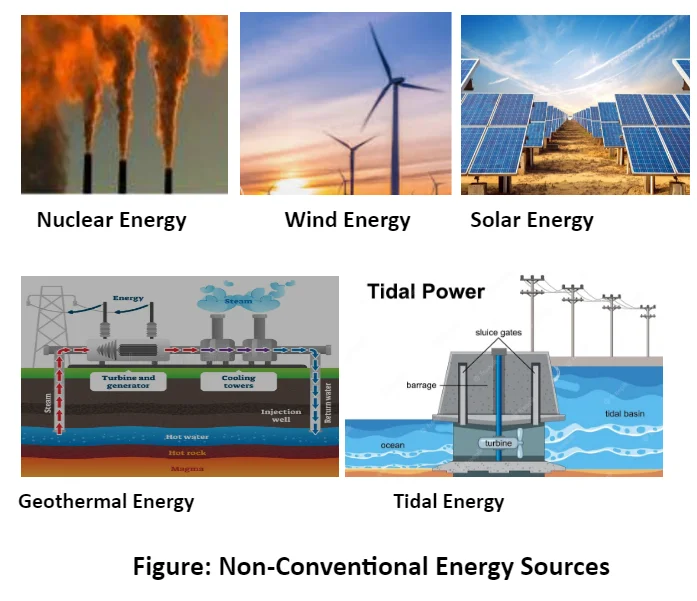Energy demand is rising, leading to dependence on fossil fuels like coal, oil, and gas. This reliance raises concerns about energy security and environmental issues. To address this, renewable sources like solar, wind, tide, biomass, and waste energy are crucial. India, with abundant sunlight, water, wind, and biomass, has significant renewable energy potential.
India’s Renewable Energy Landscape (as of December 2023)
- Total Capacity: 179.57 GW (including large hydro, Source: Central Electricity Authority).
- Breakdown: Solar: 73.32 GW (56.92 GW ground-mounted, 11.08 GW grid-connected rooftop); Wind: 42.868 GW; Biomass/Co-gen: 10.248 GW; Small Hydro Power: 4.944 GW; Waste To Energy: 554 MW; Large Hydro: 46.88 GW
- Renewables Share: 42% of total installed capacity.
A. Solar Energy
- India’s Solar Potential: India’s tropical climate offers vast solar energy potential. The western part of India has greater potential for the development of solar energy in Gujarat and Rajasthan.

- Photovoltaic Technology: converts sunlight into electricity.
- Increasing Rural Solar Power: Solar power adoption is increasing, especially in rural areas, reducing reliance on traditional fuels.
- Advantages: Abundant sunlight, low maintenance, clean power, grid tie-up benefits.
- Challenges: Grid integration, energy storage improvements needed.
B. Wind Energy
- Distribution: Tamil Nadu, Andhra Pradesh, Karnataka, Gujarat (Lamba is famous for wind power plants), Kerala, Maharashtra and Lakshadweep have important wind farms. Nagercoil and Jaisalmer are well known for the effective use of wind energy in the country.
- Position: 5th globally in wind power capacity.
- Gujrat: has the highest wind power potential (in GW) at 120 m Above Ground Level.
C. Tidal and Wave Energy
- Ocean tides can generate electricity through floodgate dams.
- The Gulf of Khambhat, the Gulf of Kachchh in Gujarat on the western coast, and the Gangetic Delta in the Sunderban regions of West Bengal provide ideal conditions for utilising tidal energy.
D. Geothermal Energy
- Source: Geothermal energy refers to the heat and electricity produced by using the heat from the interior of the earth.
- Experimental Projects in India: There are several hundred hot springs in India; two experimental projects have been commissioned at Manikaran in Himachal Pradesh and in the Puga Valley, Ladakh.
E. Bio-energy
- Bio-energy refers to energy derived from biological products which includes agricultural residues, municipal, industrial, and other wastes.
- Examples: Firewood, shrubs, straws, human waste, etc.
- Biogas Plants: including ‘Gobar gas plants,’ improve energy access and provide high-quality manure.
- Applications: It can be converted into electrical energy, heat energy, or gas for cooking.
F. Nuclear Energy Resources
- Raw Materials: Uranium, Thorium, Heavy water, Zirconium, Helium.
- Uranium: Silvery-gray, naturally in supernova explosions.
- Distribution in India: Jharkhand, Meghalaya, Andhra Pradesh, Karnataka, Rajasthan (Dharwar rocks, Singhbhum Copper belt, Udaipur, Alwar, Jhunjhunu, Durg, Bhandara, Kullu)
- Global Distribution: Major Deposits: Australia, Kazakhstan, Canada.
- Thorium: Thorium is mainly obtained from monazite and ilmenite in the beach sands along the coast of Kerala and Tamil Nadu.
- The world’s richest monazite deposits occur in Palakkad and Kollam districts of Kerala, near Visakhapatnam in Andhra Pradesh and Mahanadi river delta in Odisha
- Indian Nuclear Plants: Tarapur (Maharashtra); Rawatbhata (Rajasthan); Kudankulam (Tamil Nadu); Kaiga (Karnataka); Kakrapar (Gujarat); Kalpakkam (Tamil Nadu); Narora (Uttar Pradesh)
| Monazite contains rare earth elements and thorium; India possesses the world’s largest monazite reserves in the beach sands along the coast of Kerala and Tamil Nadu; Only Government bodies can process and export monazite; Uranium is found in igneous and metamorphic rocks in India [UPSC 2022] |
Conclusion
- India’s pursuit of non-conventional energy sources aims to address energy security and environmental concerns.
- Utilizing abundant renewable resources like solar, wind, and biomass reduces dependence on fossil fuels.
- Adoption of these technologies promotes rural development, environmental conservation, and sustainable energy access.
![]() May 4, 2024
May 4, 2024
![]() 4307
4307
![]() 0
0
